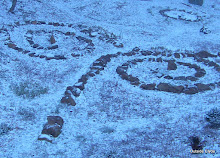
I did not even know these roses at the front entry were here until they started blooming. A very steep slope is rather difficult for Bulbarella or her assistant to weed, so I went up there and cut out a lot of tree saplings and yanked out a lot of the Clematis virginiana that was covering them up.

Yarrow, Achillea millefolium is joining the Ox-eye Daisy in an early summer sweep of white across the front of the ridge top garden.

Down at my place the Dahlia 'Madame Simone Stappers', a recent immigrant from the west coast has emerged from a bulbous slumber. I have been eyeing the known gardens with Dahlias down in the valley when I drive to town. Those came up several weeks ago and were definitely left in the ground over the winter. That means Madame Stappers has a chance of making a go of it here since I am unwilling to coddle a plant by digging and storing it for the winter. It is enough that I will be filling the planting hole to the main soil level this first year as the Dahlia grows.

The Mundane Lilies are just beginning what will be a floral explosion. I am torn. They are so common that they can feel dull and boring, but they are such reliable work horses it would be silly to dismiss them.

You have to be quick to get a picture before the pollinators move in.

The Plain-tain Lily is another one of the common work horse plants whose bold foliage in the shade will be hard not to make use of.

Who can resist something like this, where choices are limited by shade and a lot of ground needs to be covered to create the illusion of a garden?

The native, Hydrangea arborescens is having a very good year. A nice drift of this was unburied along the roadside at my place. I will need to get back in there soon to keep the Blackberries and Clematis from encasing them again.

This I suspect is one of the many cultivated varieties of the native Hydrangea. It has more of the larger sterile flowers.

Lysimachia quadrifolia, Whorled Loosestrife is a subtle player in the wildflower show.

Unlike the high drama of the Eremurus. They look to me like Bulbine on steroids.

The flower spikes have been having a lengthy bloom display and there are three more plants to go. If this patch settles in and expands, the future shows could be traffic stoppers.






5 comments:
I just love those yellow Foxtail Lilies. I bet they will expand, slowly, if they are like mine. I planted three and now there are four. They have been mistakenly moved a time or two though. The foilage dies back and I forget where they are.
Your wild hydrangeas are pretty. I like all the wildflowers. Roses are a treat too.
Hi Christopher, those eremurus are driving me wild, I want them to grow here so badly. Lisa at greenbow has some in her garden also, and she is definitely not desert. They even had flooding and standing water this spring. The hydrangea derived from the native is most likely Annabelle. Bulbarella would have wanted one of those. We have some dahlias that overwinter. Bishop's Children grown from seed has made it before. Daughter Semi buys them in packages at Walmart and they all come back for her in Knoxville. What is that technique about filling in the planting hole? And what is saprolite soil?
Lisa I know some people who forget where they plant things. I bet the same will happen to me as I plant more and more areas. The wild hydrangeas are totally lining the road up to here in places.
I don't know what to tell you about the Eremrus Frances. I planted the root stocks and they came up. If they do it again next spring and are bigger, than I can be sure they like it here.
The planting instructions for the Dahlia bulb said to plant it six inches deep, cover with two inches of soil and fill in to the regular soil level as it grew. Maybe this encourages more rooting and tuber formation. The foliage reminds me an awful lot of potatoes.
Saprolite is a soil of partially decomposed rock. It is kind of gritty with touches of clay. It is not allowed for septic drain fields because it drains too well. Water does not stay in the soil long enough for microbial breakdown of the effluent I guess. The ridge where the cabin and future house will be was all saprolite. Thank goodness there was acceptable soil for a drain field across the utility valley and below the road.
Penelope Hobhouse was just advocating the use of red dahlias and associated hot color palettes in dry shade on the DVD I'm watching. Judging by the pictures on the TV, I had to agree with her. I have found dahlias take more shade than the books say. They might flower a little bit less, but that can be a good thing for a dahlia whose florific abundance can be a little hard to take.
I think the burying while growing helps reduce the urgency of staking later on when the plant is very top-heavy.
The foliage reminds you of potatoes--that's funny because I'm staking mine with small tomato cages this year and I must say the dahlias look perfectly appropriate in a tomato cage.
I love that beautiful, wild-looking rose! Reminds me of my 'Dortmund' with the dark red petals and the white eye.
And I keep trying not to revert to using too many hostas, but keep failing. It's not just how easy they are, it's the relative lack of chunky-leaf shade plants to provide a foil for the pretty, delicate things.
Post a Comment